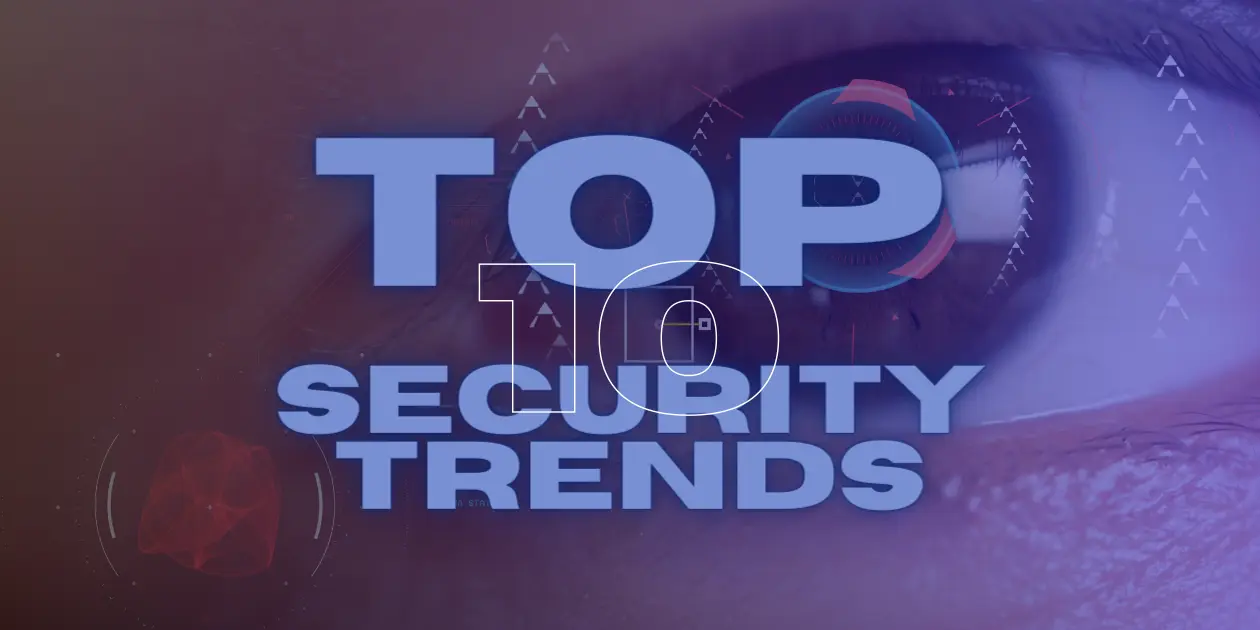As we welcome the new year and embrace emerging technologies, the first week of 2024 presents us with the perfect moment to reveal the expected physical security trends of this year. We are eager to explore the upcoming advancements and encourage you to consider innovative approaches to integrating these trends into your physical security strategy. Let’s discuss the top 10 physical security trends of 2024.
1. AI and Machine Learning as a Prevention Method
The integration of Artificial Intelligence (AI) and Machine Learning (ML) is everywhere so it’s natural that we would also see it leveraged in physical security systems. Here's an in-depth look at how these technologies will specifically enhance physical security.
Real-Time Monitoring and Analysis: AI-enabled cameras and sensors will perform real-time analysis of video feeds. This means instant identification of unusual activities or behaviors, such as loitering, unattended packages, or unauthorized access attempts.
Facial Recognition Technology: AI-driven facial recognition will become more advanced, allowing for the quick identification of individuals on watchlists. This technology will be crucial in crowded public spaces like airports, train stations, and shopping centers.
Behavioral Analysis: Machine learning algorithms can analyze patterns of behavior and predict potential security threats. For instance, an AI system could identify someone repeatedly scouting a location as a potential threat.
Anomaly Detection: AI systems will be trained to recognize normal patterns and flag anomalies. This could include identifying vehicles parked in unusual locations or detecting suspicious package placements.
Alert Generation: Upon detecting a potential threat, AI systems will automatically alert security personnel, reducing response times and improving incident management.
Integrated Response Protocols: AI can integrate with other security systems (like automated door locks or alarm systems) to initiate a coordinated response to security breaches.
Crowd Management: AI can analyze data to manage crowd flow and density, especially in event settings, reducing the risk of stampedes or overcrowding.
Heat Maps of Incidents: Machine learning algorithms can create heat maps of security incidents, helping to identify high-risk areas where additional measures may be needed.
Optimal Resource Allocation: AI systems can analyze past incidents and resource usage to suggest optimal placement of cameras, sensors, and security personnel.
Maintenance Predictions: AI can predict when equipment might fail or need maintenance, ensuring that all security systems are operational and effective.
AI and ML will significantly enhance physical security, offering more proactive, efficient, and adaptive solutions. These technologies will not only streamline security operations but also provide a level of analytical insight and predictive capability that we haven’t seen before.
Our Blog
Subscribe to the Prime Secured blog to receive the latest updates.
2. Advanced Biometric Security Systems
In the near future, advanced biometric security systems are set to transform the way we think about keeping spaces secure. Imagine walking into a building and being recognized instantly – not just by your face but also by your iris pattern or even the way you walk. This isn't science fiction anymore; it's the reality of sophisticated biometric technologies like facial recognition, iris scanning, and gait analysis becoming commonplace. These high-tech methods are a game-changer, offering a level of security far beyond what traditional systems could, mainly because they're so much tougher to trick.
But it's not just about scanning physical features. The security world is buzzing about something called behavioral biometrics. This cool tech dives into the unique ways we behave – like the rhythm of our typing or our distinct walking patterns. By focusing on these behaviors, security systems can get to know us in a whole new way, making checks thorough but not intrusive. Think of it as the system getting to know the real you, not just your ID card. And with security becoming more a part of our daily lives, these systems are being designed to blend in seamlessly. Imagine just walking through a door, no swiping, no stopping – the system just knows it's you.
Of course, with all this personal data floating around, keeping it safe is top priority. Rest assured, the tech gurus are all over this, ensuring our biometric data is locked down tight against cyber snoops. And here's the cherry on top: these advanced biometric systems aren't just for high-security areas. They're making their way into our everyday lives, popping up in places like stores, hospitals, and customer service centers, making things not only safer but also a bit more personal. Welcome to the future of security – where safety meets convenience.
Example of how AI can transform existing technology, such as turnstiles, into an advanced biometric system. Video credit: Alcatraz.AI
3. Increased Use of Drones for Surveillance
Drones, equipped with advanced cameras and various sensors, offer a highly mobile and adaptable solution for surveillance needs, making it a go- to solutions for monitoring hard to reach areas. This is especially valuable in large-scale environments like border regions, industrial complexes, and during massive public events where traditional surveillance methods may fall short. Unlike fixed security cameras or manned patrols, drones can quickly cover vast areas, providing real-time feedback and data. Their ability to hover and maneuver in diverse terrains enables a more comprehensive and dynamic approach to monitoring, ensuring that even the most secluded or challenging locations are under watch.
The versatility of drones extends beyond observation. They can be outfitted with a range of technological advancements, including thermal imaging, night vision, and motion sensors, enhancing their effectiveness in various conditions and times of the day. This adaptability makes drones invaluable for emergency response scenarios, such as natural disasters or search and rescue operations, where timely and extensive area coverage is crucial. As drone technology evolves, there is a growing potential for integrating artificial intelligence to analyze the data they collect, paving the way for more proactive and predictive security measures. Such advancements not only improve the efficiency of surveillance operations but also significantly reduce the risk and cost associated with deploying human personnel in potentially hazardous environments.
4. Smart Access Control Systems
Smart access control systems are becoming more sophisticated, integrating with other building management systems. In 2024, we will see a rise in the use of smart locks, keyless entry systems, and mobile-based access controls. These systems not only enhance security but also offer convenience and efficiency for users.
5. Focus on Cybersecurity in Physical Security Devices
Every year, the increase in cybersecurity attacks grows with new technologies advancing their tactics, and as more devices are connected to the internet, it is no surprise that there will be an increased focus on the cybersecurity of physical security systems. Manufacturers and users will need to ensure that devices are secure from hacking and data breaches. To Learn more about the advancements made in cyberthreats we encourage you to review: 6 Cybersecurity Trends to Watch for in 2024.
6. Rise of Security as a Service (SECaaS)
Security as a Service (SECaaS) is gaining popularity, offering physical security solutions on a subscription basis. This model provides scalable and customizable security options, making high-quality security systems more accessible to smaller businesses and organizations.
Adopting the Security-as-a-Service model brings not only cost savings but also enhanced flexibility. This innovative payment approach optimizes financial resources while ensuring that security measures are robust and adaptable.
If this payment model is something you wish to further investigate, we have a few resources dedicated toward the topic: Learn more about PSaaS here.

7. Green Security Solutions
Sustainability is set to play a significant role in shaping physical security trends. As we look towards 2024, expect to see a rise in eco-friendly security solutions, including solar-powered cameras and energy-efficient security systems. This shift is not only aligned with environmental objectives but also offers the advantage of reducing operational costs.
For a deeper understanding of how sustainability is currently influencing the physical security space, we recommend reading a blog by Genetec, which provides insightful perspectives on sustainability in physical security.
8. Increased Importance of Privacy and Ethical Concerns
As surveillance technologies continue to transform, they bring with them a heightened focus on privacy and ethical concerns. The increasing capabilities of these systems, while beneficial for security, also raise important questions about individual privacy rights. We can expect that, in response, regulations and guidelines governing the use of surveillance technologies will undergo review. These changes will aim to strike a delicate balance between upholding robust security measures and protecting the privacy and rights of individuals.
According to the Council on Foreign Relations, organizations and governments will likely be encouraged, or even mandated, to disclose how they're using surveillance technologies and what measures are in place to protect collected data. Additionally, there will be a growing emphasis on consent and the rights of individuals to know when and how they are being monitored. The dialogue around ethical use of surveillance will also extend to include debates on bias and fairness, particularly in AI-driven systems, ensuring that these technologies are used responsibly and do not discriminate against certain groups.
9. Emphasis on Integrated Security Solutions
The concept of integrated security solutions, which merge physical and digital security strategies, is indeed becoming a standard in the security landscape. This holistic approach recognizes that threats can be both physical and digital, and therefore, a comprehensive security strategy must address all potential vulnerabilities.
Integrated security solutions often include a combination of surveillance systems, access control, intrusion detection, cybersecurity measures, and response protocols. By combining these elements, organizations can ensure a more robust defense against a wide range of threats. For instance, access control systems not only manage physical entry but are also integrated with IT systems to control access to sensitive data. Similarly, surveillance systems are not just about monitoring physical spaces but also include network surveillance to detect cyber threats.
10. Use of Predictive Analytics for Threat Assessment
Finally, predictive analytics will play a crucial role in threat assessment and management. By analyzing historical data and current trends, security systems can predict potential security breaches or threats, enabling proactive measures to prevent incidents.
The Future of Security is Bright
As our discussion on the top 10 physical security trends of 2024 comes to an end, it's apparent that the future of security is promising, with a strong focus on proactive measures rather than reactive ones. The integration of Artificial Intelligence (AI) and Machine Learning (ML) in enhancing threat detection, alongside the personalization offered by advanced biometric systems, signifies a major shift towards security solutions that are not only more proactive and efficient but also more user-friendly. The use of drones for versatile surveillance, the implementation of smart access controls for seamless entry, and the heightened emphasis on cybersecurity highlights the need for a comprehensive approach to security.
The rise of Security as a Service (SECaaS) represents a trend towards more adaptable and cost-effective security models, which are accessible to businesses of all sizes. Concurrently, the adoption of green security solutions reflects an increased recognition of environmental concerns, effectively combining sustainability with safety. The growing significance of privacy and ethical issues in surveillance points to a more balanced method, one that respects individual rights while maintaining robust security measures.
Are you ready to explore whether the exciting security trends we've discussed are the right fit for your organization? The future of security is indeed bright, and at Prime Secured, we're here to help you navigate it. Contact us to start a conversation about how these innovative solutions can benefit your organization.
Leave Your Comments Below:

